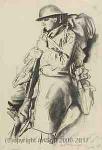Eric Henri Kennington
Eric Henri Kennington
Place: Chelsea
Born: 1888
Death: 1960
Biography:
Eric Henri Kennington RA was an English sculptor, artist and illustrator, and an official war artist in both World Wars.
As a war artist, Kennington specialised in depictions of the daily hardships endured by soldiers and airmen. In the inter-war years he worked mostly on portraits and a number of book illustrations. The most notable of his book illustrations were for T. E. Lawrence's Seven Pillars of Wisdom. Kennington was also a gifted sculptor, best known for his 24th East Surrey Division War Memorial in Battersea Park, for his work on the Shakespeare Memorial Theatre in Stratford-upon-Avon and for the tomb effigy of Lawrence at Wareham in Dorset.
Kennington was born in Chelsea, London, the second son of the well-known genre and portrait painter, Thomas Benjamin Kennington (1856–1916), a founder member of the New English Art Club. He was educated at St Paul's School and the Lambeth School of Art. Kennington first exhibited at the Royal Academy in 1908. At the International Society in April 1914 Kennington exhibited a series of paintings and drawings of costermongers which sold well and allowed him to set up a studio off Kensington High Street in London.
At the start of World War I, Kennington enlisted with the 13th (Kensington) Battalion London Regiment on 6 August 1914. He fought on the Western Front, but was wounded in January 1915 and evacuated back to England. Kennington was injured while attempting to clear a friend's jammed rifle and he lost one toe and was fortunate not to lose a foot due to infection. He spent four months in hospital before being discharged as unfit in June 1915. During his convalescence, he spent six months painting The Kensingtons at Laventie, a group portrait of his own infantry platoon, Platoon No 7, 'C' Company. Kennington himself is the figure third from the left, wearing a balaclava. When exhibited in the spring of 1916, its portrayal of exhausted soldiers caused a sensation. Painted in reverse on glass, the painting is now in the Imperial War Museum and was widely praised for its technical virtuosity, iconic colour scheme, and its "stately presentation of human endurance, of the quiet heroism of the rank and file".
Kennington visited the Somme in December 1916 as a semi-official artist visitor before, back in London, producing six lithographs under the title Making Soldiers for the Ministry of Information's Britain's Efforts and Ideals portfolio of images which were exhibited in Britain and abroad and were also sold as prints to raise money for the war effort. In May 1917 he accepted an official war artist commission from the Department of Information. Kennington was commissioned to spend a month on the Western Front but he applied for numerous extensions and eventually spent seven and a half months in France. Kennington was originally based at the Third Army Headquarters and would spend time at the front lines near Villers-Faucon. Later during this tour, his friend William Rothenstein was also appointed as a war artist and they worked together at Montigny Farm and at Devise on the Somme, where they often came under shell-fire. Kennington spent most of his time painting portraits, which he was happy to do, but became increasingly concerned about his lack of access to the front line and that the official censor was removing the names of his portrait subjects. Although Kennington was among the first of the official war artists Britain sent to France, he was not afforded anything like the status and facilities that the others, in particular William Orpen and Muirhead Bone enjoyed. Whereas Kennington was working for neither salary nor expenses and had no official car or staff, Orpen was given the rank of major, had his own military aide, a car and driver, plus, at his own expense, a batman and assistant to accompany him. Kennington could be aggressive and irritable and at times complained bitterly about his situation, claiming he must have been the cheapest artist employed by the Government and that "Bone had a commission and Orpen had a damned good time".
During his time in France, Kennington produced 170 charcoal, pastel and watercolours before returning to London in March 1918. Whilst in France in 1918, Kennington was admitted to a Casualty Clearing Station at Tincourt-Boucly to be treated for trench fever. There he made a number of sketches and drawings of men injured during the bombardment that preceded the German 1918 Spring Offensive. Some of these drawings became the basis of the completed painting Gassed and Wounded.
Throughout June and July 1918 an exhibition of Kennington's work, "The British Soldier", was held in London and received great reviews and some public acclaim. Despite this, Kennington was unhappy in his dealings with Department of Information, mainly concerning the censoring of his paintings, and he resigned his war artist commission with the British. In November 1918 Kennington was commissioned by the Canadian War Memorials Scheme to depict Canadian troops in Europe. That month he returned to France as a temporary first lieutenant attached to the 16th Battalion (Canadian Scottish), CEF. The eight months Kennington spent in Germany, Belgium and France, working for the Canadians, resulted in some seventy drawings.
More...
Wikipedia link: Click Here











